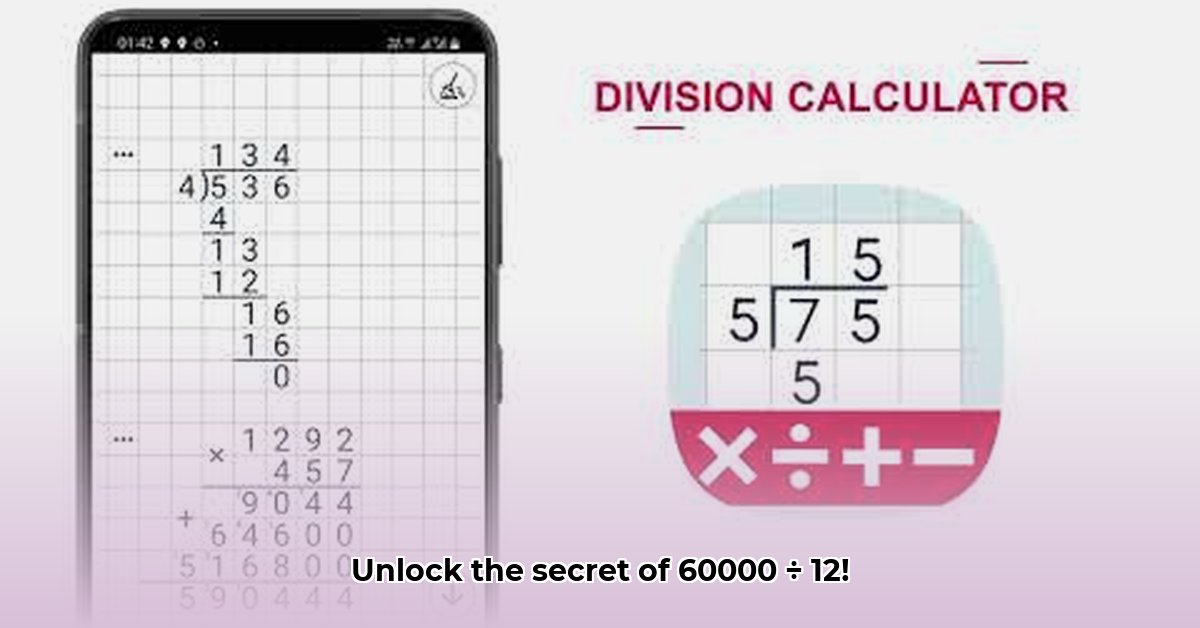
Ever wondered what happens when you divide 60,000 by 12? It's more than a simple calculation; it's a window into fundamental mathematical concepts. This guide provides a step-by-step solution, explores the underlying mathematical principles and demonstrates its real-world applications. Whether you're a student brushing up on your math skills, an educator seeking illustrative examples, or a programmer optimizing code, this detailed exploration will provide valuable insights. For a similar problem, check out this related example.
Understanding the Fundamentals: Whole Number Division
This problem involves integer division, focusing solely on whole numbers—no fractions or decimals. The fact that 60,000 divided by 12 yields a whole number (5000) signifies perfect divisibility; 12 divides evenly into 60,000 with no remainder. This seemingly simple observation opens the door to exploring the elegance of mathematical properties. Why does this division result in a clean, whole number answer? Let's delve deeper. Is this always the case with large numbers divided by smaller ones?
Using Shortcuts: Divisibility Rules to Our Advantage
Before reaching for a calculator, let's utilize divisibility rules—mathematical shortcuts to determine if a number is cleanly divisible by another without performing lengthy calculations. A number is divisible by 12 if it's divisible by both 3 and 4. Is 60,000 divisible by 3? Yes. The sum of its digits (6 + 0 + 0 + 0 + 0 = 6) is divisible by 3. Similarly, a number is divisible by 4 if its last two digits are divisible by 4. The last two digits of 60,000 are 00, a multiple of 4. Therefore, 60,000 is divisible by 12.
A Step-by-Step Approach: Breaking Down the Problem
Let's systematically solve 60,000 divided by 12, emphasizing the underlying logic:
Step 1: Strategic Simplification: Instead of directly tackling 60,000 / 12, let's consider (60,000 / 10) / 1.2. This breaks the problem into smaller, manageable parts.
Step 2: Simple Division by 10: Dividing by 10 is straightforward: shift the decimal point one place to the left. 60,000 becomes 6,000.
Step 3: Addressing 1.2: Now, we divide 6,000 by 1.2. Express 1.2 as the fraction 12/10. Our problem becomes: 6,000 / (12/10). Recall that dividing by a fraction is equivalent to multiplying by its reciprocal (inverting the fraction). This simplifies to 6,000 * (10/12), which further reduces to 5,000.
Step 4: Verification: Multiply 12 by 5000. The result, 60,000, confirms our solution. This verification step is crucial in mathematical problem-solving, ensuring accuracy and building confidence in the calculation. How often do you verify your solutions? It is a critical step in avoiding simple errors.
Delving Deeper: Exploring the Mathematical Landscape
This seemingly basic calculation unveils a rich tapestry of mathematical concepts.
Prime Factorization: Prime factorization decomposes a number into its prime factors (numbers divisible only by 1 and themselves). The prime factorization of 60,000 is 2⁵ * 3 * 5⁴, while 12's is 2² * 3. Note that all prime factors of 12 are present in 60,000. This explains the clean division—no leftover prime factors. Understanding prime factorization is essential in various mathematical fields.
Modular Arithmetic: This branch of math focuses on remainders after division. In our example, the remainder is 0, meaning 60,000 is congruent to 0 modulo 12. This concept is fundamental in areas such as cryptography and computer science. What are some examples of real-world applications of modular arithmetic outside of cryptography and computer science?
Practical Applications: Putting Math to Work
The 60,000 divided by 12 calculation has numerous real-world applications:
Budgeting: Dividing a $60,000 annual budget into 12 months yields a $5,000 monthly budget.
Manufacturing: Producing 60,000 units across 12 production runs results in an average of 5,000 units per run.
Software Development: Software engineers use similar calculations to allocate resources or check numerical algorithm results.
Education: The problem serves as a fundamental teaching tool for division and divisibility rules.
Real-World Examples in Action
This table summarizes various applications:
| Scenario | Calculation | Result | Real-World Implication |
|---|---|---|---|
| Annual Salary | $60,000 ÷ 12 months | $5,000/month | Monthly income |
| Inventory Management | 60,000 items ÷ 12 shipments | 5,000 items/shipment | Average items per shipment |
| Project Timeline | 60,000 tasks ÷ 12 weeks | 5,000 tasks/week | Weekly task allocation for a project |
In closing, while the answer to 60,000 divided by 12 is simply 5000, the process unveils a wealth of mathematical concepts and practical applications. It's a testament to the beauty and utility of mathematics, demonstrating how seemingly simple calculations can unlock profound understanding and real-world problem-solving capabilities.